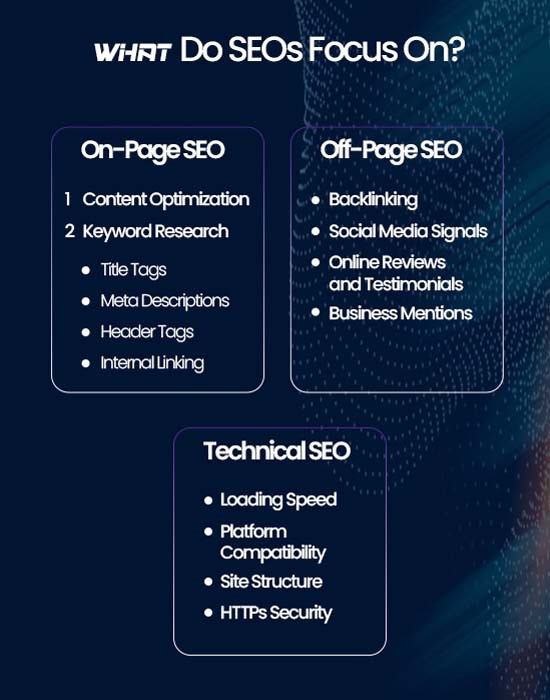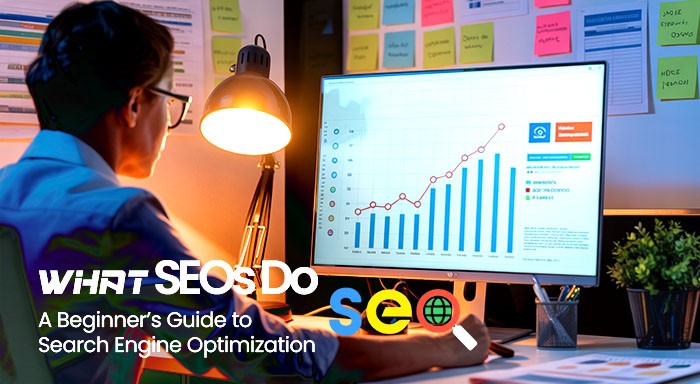What is SEO? Search Engine Optimization (SEO) is the technique that is implemented to improve the visibility and ranking of a website or its content on the result pages of
What is SEO?
Search Engine Optimization (SEO) is the technique that is implemented to improve the visibility and ranking of a website or its content on the result pages of a search engine like Google, Yahoo, Bing, etc. There are three types of SEO, namely on-page SEO, off-page SEO and Technical SEO. When combined, they optimise your website and its content for the search engine algorithms to comprehend them as valuable and relevant. By adopting SEO practices, SEOs (Search Engine Optimizers) ensure that your website appears prominently when users search for queries related to your business, products, or services.
Who Are SEOs and Why Are They Important?
In today’s overcrowded jungle of the web, reaching the right audience is no easy task. This is where SEOs (Search Engine Optimizers) play a vital role. These professionals specialize in boosting a website’s visibility and performance across search engines like Google. Here are some key reasons why SEOs are essential for businesses and digital platforms:
Improved Rankings and Visibility
When people want information, they use a search engine that surfs the web for them and displays all the results relevant to the input. Most users click on the top-ranking results of the search engine results page (SERPs). Very few go through the rest of them. SEOs improve the ranking of your website on the SERPs and make it more visible to your targeted audiences.
Sustainable Traffic Growth
SEO ensures that your website reaches the right audiences with an interest in the relevant industry and your offered products or services, as indicated by their searches. As a result, there would be an increasing number of visitors on your website driving up your traffic rates. The results of SEO implementation may not be instantaneous, but it produces long-term sustainable growth for your business.
Business and Marketing Strategy
With improved visibility and increased traffic, Search Engine Optimization becomes a cost-effective marketing tool. It enables your website to expand its reach without the need for excessive efforts or paid ads. All three SEOs do not require fancy software, high end infrastructure, or complex algorithms and can operate with minimum resources. They also boost your retention rates as higher rankings create a sense of trust among the customers and contributes to the credibility of your business.

Better User Experience
One of the major aspects of SEO is to optimise your website for improved speed, navigation structure, and mobile accessibility. This makes your website platform friendly and enhances customer experience. The higher the convenience and accessibility that your website offers to the users, the more time they would be willing to spend in it. Satisfying user experience increases conversion rates and creates a loyal customer base.
How Do Search Engines Work?
To implement the SEOs efficiently, it is essential to gain a basic understanding of how the search engines operate. Here is a brief description of all the steps taken by a search engine to determine the ranking of your content:
- Crawling: Search engines use AI-powered automated algorithms called "bots" or "spiders". These spiders crawl across the internet to discover web pages and scan them.
- Indexing: After crawling, search engines analyse and store the scanned data contained in each page of your website in their massive databases (index).
- Ranking: When a query has been made, the search engines use AI-Integrated complex algorithms to evaluate the information on the webpages and determine their value. Then it displays them on the SERPs based on the perceived quality and relevance.
What Do SEOs Focus On?

SEOs focus on a variety of tasks that contribute to improving a site’s performance in search engine rankings. Their work typically falls into three key categories:
On-Page SEO
On-page SEO involves optimizing all the content on your website and its individual landing pages to make it more relevant to a user’s query. This way your website would rank higher. Following are the key elements of On-page SEO:
Keyword Research:
Keyword research lays the foundation for SEO and its techniques. Keywords are the popular words and phrases that are used commonly by the users to make a query on the search engines. You can use tools like Google Keyword Planner or SEMrush to find:
- The words and phrases that are being used by your target audiences.
- The frequency with which those words and phrases are being used.
- Strength of those keywords in your current industry.
Keyword research and analysis would give you an idea about the current interest of your target audience. You can use it to update the existing content on your website, create new content and devise a content plan for future content. This way, you can create content catering to the latest industrial trends and keep yourself ahead of your competitors.
Content Optimization:
It is crucial to create high-quality, valuable content that provides information to address the users’ queries. When creating your content, make certain that:
- Your content is original and informative. It should be accurate with no false information or spamming.
- The content should be well-organised and structured in a hierarchical format. It should have distinct title, headings and subheadings with proper segmentation.
- Your content should be comprehensive and address the topic.
- Review and update your content regularly to keep it fresh and aligned with the latest trends.
Following are the key elements of that optimise your content and make it SEO-friendly:
- Title Tags: They are the headlines that appear on the SERPs. Your title tag should convey the intent of your content, be eye-catching, and compelling to grab the user’s attention. It should not exceed 60 characters.
- Meta Descriptions: These are the brief descriptions or summary that appear under the title on the SERPs and give a quick idea to the audiences on what to expect if they click on the link. They should be clear and concise and should not exceed 160 characters.
- Header Tags: Use H1, H2, H3 tags to mark your headlines and create a hierarchical structure for your content. This will ensure that your content is well-organized, easy to understand, seemingly credible, and facilitate navigation for the users as well as search engine ‘spiders’.
- Internal Linking: You can add links to different relevant pages on your content and website so that you can create a structured pathway for the users to follow. This way, they will explore different pages of your website in a favourable order and spend more time on it.
Off-Page SEO
Off-page SEO refers to the processes that take place outside your website but contribute to the improvement of your rankings. Following are the elements of off-page SEO:
- Backlinking: When other websites add a link to your website on their content, it’s called backlinking. This acts like a recommendation or a vote of confidence from someone else in the same industry or having a knowledge of your industry and can be mutually beneficial for both the businesses. Backlinks in SEO will guide the traffic in your direction with users looking for the exact products or services that you offer and act as precision marketing.
- Social Media Signals: Though social media shares do not have a direct contribution to your search engine rankings, they can influence the popularity of your business. This will drive up traffic rates, create brand trust, and prompt more backlinking from other businesses.
- Online Reviews and Testimonials: It is important for your business to have positive reviews on Google My Business, and industry-specific platforms. This will build trust among the new customers who can rely on the words and testimonials of your older customers and their shared experiences. It will also improve rankings on localised searches.
- Business Mentions: Even when a backlink for your website has not been added in the content, the mention of your business on other websites will add to its recognition and authority in the industry. This will drive up traffic rates and improve the credibility of your business.
Technical SEO
Technical SEO is involved with optimisation of the technical aspects of your website. Its implementation makes it convenient for the search engine algorithms to crawl through your website, analyse and understand the content, and index it into the database. While ranking them, search engines give preferences to websites that perform better and offer enhanced user experience. Some of the key elements are:
- Loading Speed: Slow-loading pages can annoy users who might get impatient and leave. Make sure that the pages of your website load fast (preferably under 3 seconds) to hold the attention of the visitors, enhance user experience, and improve rankings.
- Platform Compatibility: Users look for easy accessibility with flexible options. Smart devices like mobile phones and tablets have become common and often searches are made on them. Ensuring that your website is platform-friendly and compatible will increase visibility on those searches and customers will find it convenient.
- Site Structure: Organise the landing pages of your website and structure them in a way that makes it easy for the users to navigate through them and find what they are looking for, without hassle. The interface should allow quick movement between different pages, and they should be inter-linked to guide the user towards the next step.
- HTTPs Security: Websites that are secure, possess SSL certification and can protect user data are prioritised by search engines and rank higher. Users also choose them over unsecured weblinks to avoid cyber risks, fake information and harm to privacy.
Best Practices SEOs Follow for Long-Term Success
Experienced SEOs don’t chase shortcuts—they follow sustainable strategies that align with search engine guidelines. Here are some best practices that successful SEOs consistently follow:
- Prioritize User Intent: They focus on creating content that genuinely answers users’ questions and satisfies their search intent.
- Use Data-Driven Insights: SEOs rely on analytics tools (like Google Search Console and Google Analytics) to monitor performance and make informed decisions.
- Keep Up with Algorithm Changes: Search engines frequently update their algorithms, and SEOs stay updated to adapt their strategies accordingly.
- Build Quality Over Quantity: Whether it’s backlinks or content, SEOs focus on quality to build long-term credibility and authority.
- Ensure Technical Soundness: Regular audits, fixing crawl errors, and maintaining clean site architecture help ensure that the site remains healthy and indexable.
- Optimize for Mobile and Speed: Mobile-first indexing and fast-loading pages are a priority for SEOs to ensure great user experiences.
By following these practices, SEOs not only boost rankings but also contribute to long-term brand growth and trust in the digital space.
Conclusion:
In the digital age, simply having a website is not enough. To truly stand out and reach the right audience, you need to ensure that your content is visible, valuable, and easy to find—and that’s exactly what SEOs do. From optimizing individual pages and building authority to improving technical performance and user experience, SEOs play a crucial role in shaping a website’s success. By understanding and applying the fundamentals of SEO, you set the foundation for long-term growth, increased traffic, and higher credibility in your industry. Whether you're a business owner, marketer, or aspiring SEO, investing in these strategies is no longer optional—it's essential.
Related Post:
Exploring 15 Affordable SEO Services for Small Businesses
Respond to this article with emojis






